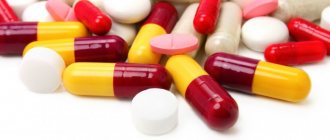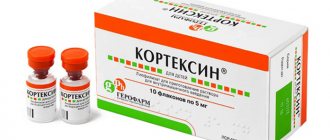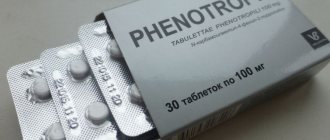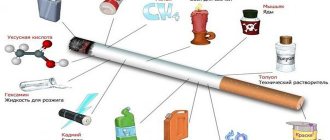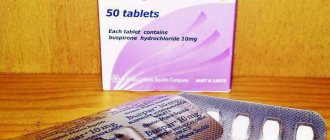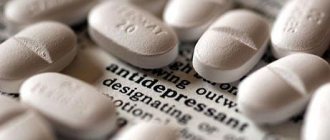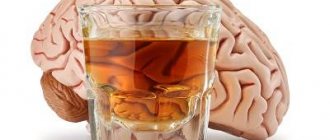Seroquel is an antipsychotic with specialized effects, mainly aimed at treating conditions associated with the risk of suicidal outcome, pronounced manic and depressive episodes, also associated with a similar risk. The group of antipsychotics is quite extensive and is divided into stimulating and sedative subgroups. They can be used in a complex technique.
The use of Seroquel is not a preventative measure for the onset of a negative episode, but only the treatment of a certain condition without a hypnotic effect, but with a sedative result. The medicine can accumulate the effect of some drugs and suppress the effect of others. The instructions for use take into account such mutual influences, but self-prescription is excluded. Obviously, such a dual impact is quite difficult to predict for an unprepared person. Therefore, independent treatment can lead to unpredictable and negative consequences.
How to Simply Recommend
Why the medicine does not work The key to successful treatment is, of course, following all the doctor’s recommendations and informing him of all significant changes during therapy. However, a specialist can talk as much as he wants about the regimen and duration of taking the drug, but most patients will still violate these rules. Read more
Analogues of the drug according to ATC codes:
VICTOEL QUENTIAX KETILEPT LAQUEL NANTARIDE SEROCQUEL PROLONG
You should consult your doctor before using Seroquel. These instructions for use are for informational purposes only. For more complete information, please refer to the manufacturer's instructions.
How much does the medicine cost?
For many patients, the question of the price of a particular medicine is extremely important. So how much does a pack of Seroquel tablets cost? The price, of course, depends on many factors, including the manufacturer, the financial policy of the pharmacy and dosage.
For example, tablets containing 25 mg of the active substance cost about 1600-1800 rubles. A drug with a dosage of 100 mg will be more expensive - its price ranges from 3,000 to 3,600 rubles. Tablets with a dose of 200 mg cost about 5500-6000 rubles.
A package of Seroquel Prolong with a dose of 200 mg of the active ingredient will cost 7,500-8,000 rubles. But tablets with the maximum dose (400 mg) cost about 15 thousand rubles. Of course, the prices are a little high, but sometimes such expenses are simply necessary.
Release form, composition and packaging
Pink, round, biconvex, film-coated tablets with “SEROQUEL 25” engraved on one side.
| 1 tab. | |
| quetiapine fumarate | 28.78 mg, |
| which corresponds to the content of quetiapine | 25 mg |
Excipients: povidone, calcium hydrogen phosphate, microcrystalline cellulose, sodium carboxymethyl starch, lactose monohydrate, magnesium stearate.
Shell composition: red iron oxide dye, yellow iron oxide dye, titanium dioxide, hypromellose, macrogol 400.
10 pieces. - blisters (6) - cardboard packs.
Yellow, film-coated tablets, round, biconvex, with “SEROQUEL 100” engraved on one side.
| 1 tab. | |
| quetiapine fumarate | 115.13 mg, |
| which corresponds to the content of quetiapine | 100 mg |
Excipients: povidone, calcium hydrogen phosphate, microcrystalline cellulose, sodium carboxymethyl starch, lactose monohydrate, magnesium stearate.
Shell composition: yellow iron oxide dye, titanium dioxide, hypromellose, macrogol 400.
10 pieces. - blisters (6) - cardboard packs.
White, film-coated tablets, round, biconvex, with “SEROQUEL 200” engraved on one side.
| 1 tab. | |
| quetiapine fumarate | 230.26 mg, |
| which corresponds to the content of quetiapine | 200 mg |
Excipients: povidone, calcium hydrogen phosphate, microcrystalline cellulose, sodium carboxymethyl starch, lactose monohydrate, magnesium stearate.
Shell composition: titanium dioxide, hypromellose, macrogol 400.
10 pieces. - blisters (6) - cardboard packs.
Price
Seroquel can be purchased at pharmacies. Costs at different points of sale may vary significantly. Prices in Moscow for the drug of different concentrations:
| Name | Price per package, rubles |
| Tablets 25 mg, No. 60 | 1720-2100 |
| Tablets 100 mg, No. 60 | 2900-3200 |
| Tablets 200 mg, No. 60 | 5480-5800 |
| Seroquel Prolong | |
| Tablets 300 mg, No. 60 | 9800 |
| Tablets 400 mg, No. 60 | 11000 |
pharmachologic effect
Antipsychotic drug (neuroleptic). Shows higher affinity for serotonin 5HT2 receptors (compared to dopamine D1 and D2 receptors) in the brain. It also has a high affinity for histamine and α1-adrenergic receptors and is less active towards α2-adrenergic receptors. It has no affinity for m-cholinergic receptors and benzodiazepine receptors.
Showed antipsychotic activity in standard tests.
Results from studies of extrapyramidal symptoms in animals revealed that quetiapine causes only mild catalepsy when exposed to a dose that effectively blocks dopamine D2 receptors. Quetiapine selectively reduces the activity of mesolimbic A10-dopaminergic neurons compared to A9-nigrostriatal neurons involved in motor function.
Clinical studies (using quetiapine in doses of 75-750 mg/day) did not reveal differences between quetiapine and placebo in the incidence of extrapyramidal symptoms and concomitant use of anticholinergic drugs.
Seroquel does not cause a long-term increase in plasma prolactin levels. Multiple fixed-dose studies have shown no difference in prolactin levels between quetiapine and placebo.
In clinical studies, Seroquel has been shown to be effective in treating positive and negative symptoms of schizophrenia.
The effect of quetiapine on 5HT2 and D2 receptors lasts up to 12 hours after taking the drug.
Pharmacokinetics
Suction
When administered orally, quetiapine is well absorbed from the gastrointestinal tract.
Food intake does not significantly affect the bioavailability of quetiapine.
Distribution
Quetiapine is approximately 83% bound to plasma proteins.
The pharmacokinetics of quetiapine is linear, and no difference is observed between men and women.
Metabolism
Actively metabolized in the liver.
It has been established that the key enzyme in the metabolism of quetiapine is the CYP3A4 isoenzyme.
The main plasma metabolites do not have pronounced pharmacological activity.
Removal
T1/2 is approximately 7 hours. Less than 5% of quetiapine is not metabolized and is excreted unchanged by the kidneys or feces. Approximately 73% of quetiapine is excreted by the kidneys and 21% in the feces.
Pharmacokinetics in special clinical situations
The average clearance of quetiapine in elderly patients is 30-50% less than that observed in patients aged 18 to 65 years.
The average plasma clearance of quetiapine was approximately 25% less in patients with severe renal impairment (creatinine clearance less than 30 ml/min/1.73 m2) and in patients with liver damage (alcoholic cirrhosis in the compensation stage), but individual clearance levels were within the range , corresponding to healthy people.
In a study of the pharmacokinetics of quetiapine, when used at various doses, when quetiapine was prescribed before taking ketoconazole or simultaneously with ketoconazole, it resulted in an increase, on average, in Cmax and AUC of quetiapine by 235% and 522%, respectively, and also in a decrease in quetiapine clearance, on average, by 84%. T1/2 of quetiapine increased, but the average time to reach Cmax did not change.
Quetiapine and some of its metabolites have weak inhibitory activity against the isoenzymes CYP1A2, CYP2C9, CYP2C19, CYP2D6 and CYP3A4, but only at concentrations 10-50 times higher than those observed at the commonly used effective dosage of 300-450 mg/day.
Based on in vitro results, coadministration of quetiapine with other drugs should not be expected to result in clinically significant inhibition of CYP-mediated metabolism of other drugs.
Seroquel: instructions for use, reviews and analogues
Psychiatric diseases occupy a special place in the structure of general morbidity. According to statistics, 18% of the total population suffers from various forms of mental disorders.
More than 65% of them are patients of working age with disabilities. This is caused not only by the exacerbation of the disease itself, but also by its consequences: the social, labor, and everyday failure of these people.
Therefore, in our time, the issue of pharmacotherapy for these conditions is acute.
The treatment of psychiatric disorders requires a long-term, individually selected regimen of drug therapy, which must ensure a harmonious balance between the effectiveness and tolerability of drugs.
In accordance with modern foreign and domestic recommendations for the management of patients with acute endogenous psychosis, Seroquel is included among the first-line drugs, which, according to the instructions for its use, is also used in the treatment of Parkinson's and Alzheimer's diseases.
General information about the drug
Seroquel is a European drug that meets the needs of rational treatment of acute endogenous psychoses. According to international guidelines, it is singled out as a drug recommended for use in psychogenic disorders.
The therapeutic activity of Seroquel, taking into account modern requirements for effectiveness and safety, has been proven in numerous randomized, blind and open, comparative and simple studies for all three main indications:
- schizophrenia;
- schizoaffective disorder;
- bipolar affective disorder.
At the same time, the drug is effective against the first and repeated episodes of the disease, as well as its recurrent forms (including both unfavorable ones with frequent exacerbations and favorable ones with rare ones).
Drug group, INN, scope of application
The drug belongs to the pharmacological group of neuroleptics - antipsychotic drugs that are used to treat psychoses of various origins. The manufacturer of the drug is AstraZeneca UK Limited, Great Britain.
From history: typical antipsychotics first appeared in psychiatric practice in 1950. The appearance of the term “neuroleptics” is associated with the property of representatives of this group of medications to influence the functioning of the extrapyramidal nervous system. It literally means “the ability to influence neurological disorders.”
International nonproprietary name (INN) is Quetiapine. It is actively used in psychiatric, neurological practices, as well as in the treatment of geriatric patients.
Release form
Seroquel is available in solid dosage form. Each of the tablets is coated, which eliminates the unpleasant taste in the mouth when swallowed. The package contains 60 tablets necessary for an optimal course of therapy.
The price of the medicine in Russian pharmacies is presented in the table.
| A drug | Pharmacy name, city | Price in rubles |
| Seroquel 25 mg, No. 60 | APTEKA LLC, Moscow | 840 |
| Pharmaceutical Leasing LLC, St. Petersburg | 852 | |
| WER.RU, Moscow | 839 | |
| Seroquel 50 mg, No. 60 | APTEKA LLC, Krasnoyarsk | 1610 |
| Farmalizing LLC, Novosibirsk | 1650 | |
| Apteka.ru, Smolensk | 1590 | |
| Seroquel 100 mg, No. 60 | Low price pharmacy, Moscow | 3300 |
| Apteka.ru, Ufa | 3410 | |
| Seroquel 200 mg, No. 60 | Laboratory of beauty and health, Moscow | 5100 |
| Farmalizing LLC, Rostov-on-Don | 4900 | |
| Online pharmacy GORZDRAV, Moscow and region | 5010 |
Instructions for use of the drug Rinzasip and reviews about it
The difference between Seroquel and Seroquel-Prolong
Seroquel Prolong is also available in the form of film-coated tablets. However, on their surface there is an XR engraving and a number indicating the dosage. This long-acting antipsychotic has slightly more dosage variations, making its use variable and convenient for a variety of conditions. According to all other criteria, both drugs are identical.
Pharmacodynamics and pharmacokinetics
The drug, being an atypical antipsychotic, actively interacts with a large number of neurotransmitter receptors in the body:
- serotonin;
- histamine;
- dopamine;
- adrenergic.
However, muscarinic and some benzodiazepine receptors remain without the influence of the drug. The mechanism of action of the drug is to effectively block D2-dopamine receptors, reducing the activity of mesolimbic A10 neurons to dopamine, thereby reducing the manifestations of schizophrenia and other psychotic conditions.
The medication is well absorbed by the mucous membrane of the digestive tract and breaks down into metabolites, which have no effect separately from each other. Taking the drug does not depend on the time of eating. The half-life is 6 hours. Most of the medication is able to bind to plasma proteins.
Indications and contraindications
The scope of Seroquel is very limited, so the list of indications is small. These include:
- acute and chronic disorders of psychotic origin (schizophrenia, schizoaffective state);
- episodes of manic behavior;
- bipolar nervous system disorders;
- Parkinson's and Alzheimer's disease in elderly patients.
It is forbidden to use the drug in the presence of individual intolerance to the components included in its composition, as well as lactase deficiency, galactose malabsorption.
The drug is contraindicated for children under 18 years of age. The use of Seroquel in pregnant and lactating women is very limited due to the lack of clinical data on its safety during this period.
Responsibility in this situation falls on the doctor: if the expected benefits outweigh the possible risks, then the option of prescribing it is possible.
However, it is worth considering that, according to the latest scientific clinical studies, the use of Seroquel in the third trimester of pregnancy threatens the occurrence of epileptic syndrome in the newborn, distress during childbirth and decreased nutrition in the first days after birth.
Use with extreme caution if:
- changes in the functioning of the vascular system in the heart and brain;
- arterial hypotension;
- liver failure;
- stroke;
- aspiration pneumonia.
Possible side effects and overdose
All undesirable effects that occur during the use of the drug are directly related to the main active ingredient - queatipine. The most common ones are the following:
- drowsiness during the day;
- headache, dizziness;
- dry mouth;
- withdrawal syndrome;
- changes in lipid metabolism - a decrease in high-density lipoproteins and an increase in low-density lipoproteins;
- obesity;
- hematological changes in the form of anemia, leukopenia;
- orthostatic hypotension;
- cardiopalmus;
- dyspeptic disorders - diarrhea, constipation, increased gas formation;
- restless legs syndrome;
- convulsions;
- dysfunction of the hepatobiliary system;
- angioedema, Stevens-Jones syndrome, anaphylactic reaction.
There are few cases of overdose. The manufacturer reports cases of death when using 13.6 g and 6 g of the active ingredient Seroquel.
However, no fatal outcome was observed with a single dose of 30 g of the drug.
Analyzing these cases, pharmacists came to the conclusion that the outcome depends not only on the underlying disease, but also on the presence of concomitant pathologies - cardiovascular, severe nephrological and hepatological disorders.
The main clinical manifestations of a drug overdose are excessive drowsiness, loss of strength, decreased blood pressure, and increased heart rate. Considering that the medication does not have specific antidotes, at the first appearance of these symptoms it is necessary to provide assistance, following the following algorithm:
- Stop taking the product.
- Give the patient a comfortable position;
- Try to rinse the stomach, give sorbents to drink (if there is no consciousness, intubate the trachea and then begin lavage).
- Administer intravenous sympathomimetic drugs.
- Transport the patient to the nearest medical facility or call an ambulance.
Analogues of the drug
The medication has analogues both in chemical composition and therapeutic effect. Complete (structural) analogues include Quentiax and Ketilept.
- Quetiax has 5 dosages. Pharmacodynamics and pharmacokinetics, indications, contraindications are absolutely identical to those of Seroquel. Produced by the Russian pharmaceutical concern LLC KRKA-RUS. The drug is a worthy replacement for the expensive Seroquel, since its price is 3 times lower.
- Ketilept is also a generic version of Seroquel, produced in Hungary at the Egis plant. Its only difference is that the tablets are contained not only in blisters, but also in glass bottles.
An analogue in pharmacological group and therapeutic effect is Ariprizole. The drug has an active substance – aripiprazole. Despite the different composition, Ariprizole is pharmacodynamically similar to the drug in question. Indications and contraindications remain standard for drugs from the antipsychotic group. , Republic of Croatia.
Instructions for use of the drug Depakine and reviews about it
Reviews from doctors
As a medication recommended by the International Psychiatric Association, its use is approved by many specialists:
- Igor Meleshko, psychiatrist: “I actively prescribe it to patients diagnosed with schizophrenia and see an immediate positive effect. Progressive dynamics develop so quickly that improvement becomes noticeable after just a week of use. I use the standard therapy regimen recommended by the manufacturer. I currently have no experience in using its analogues.”
- Ilona Timoshina, geriatrician: “I work with elderly patients who, like no one else, require a special approach to treatment. This is due, first of all, to the presence of many concomitant diseases. A minimal number of contraindications make Seroquel a favorite in geriatric practice. It is excellent in reducing the signs of Alzheimer's disease. Together with general neurological drugs, it has a positive effect on the course of Parkinson's disease. I recommend!"
Seroquel: DOSAGE
Seroquel should be taken 2 times a day, regardless of meals.
For adults for the treatment of acute and chronic psychoses, including schizophrenia, the daily dose for the first 4 days of therapy is: 1st day - 50 mg, 2nd day - 100 mg, 3rd day - 200 mg, 4th day - 300 mg.
Depending on the clinical effect and individual patient tolerance, the dose can vary from 150 mg to 750 mg/day. The maximum daily dose is 750 mg.
To treat manic episodes in bipolar disorder, quetiapine is used as monotherapy or as adjuvant therapy to stabilize mood.
The daily dose for the first 4 days of therapy is: 1st day - 100 mg, 2nd day - 200 mg, 3rd day - 300 mg, 4th day - 400 mg. Subsequently, by the 6th day of therapy, the daily dose of the drug can be increased to 800 mg. The increase in the daily dose should not exceed 200 mg/day.
Depending on the clinical effect and individual tolerance, the dose can vary from 200 mg to 800 mg/day. Typically, the effective dose is from 400 mg to 800 mg/day. The maximum daily dose is 800 mg.
For the treatment of depressive episodes in the structure of bipolar disorder, Seroquel is prescribed once a day at night. The recommended dose is 300 mg. The daily dose for the first 4 days of therapy is: 1st day - 50 mg, 2nd day - 100 mg, 3rd day - 200 mg, 4th day - 300 mg. The maximum daily dose is 600 mg. No clinical improvement was noted when the dose was increased to more than 600 mg.
In elderly patients, the initial dose is 25 mg/day. The dose should be increased daily by 25-50 mg until an effective dose is reached, which is likely to be less than in younger patients.
In patients with renal or hepatic insufficiency, it is recommended to begin therapy with Seroquel at 25 mg/day. It is recommended to increase the dose daily by 25-50 mg until an effective dose is achieved.
The safety and effectiveness of quetiapine have not been studied in children and adolescents.
Indications for use and dosage
A narrowly targeted antipsychotic is prescribed by a psychiatrist for conditions where it has shown the greatest effectiveness. This is bipolar disorder and the manic and depressive episodes that occur in its structure. The main indication of Seroquel is the treatment of schizophrenia and moderate to severe episodes, but not preventive measures. The second form of release is Seroquel Prolong - a drug that is used not only for the treatment, but also for the prevention of such disorders, and as a component of the combined treatment of depressant overdose. The property of Prolong to retain the therapeutic effect for a longer time does not affect the main quintiapine.
The drug is taken on an empty stomach, an hour before meals, swallowed whole and washed down with water. Seroquel is prescribed by a psychiatrist 2 times a day, based on clinical studies that have shown that this form of administration is optimal. If an analogue is selected, the patient needs additional consultations with the attending physician to adjust the dosage and set the optimal time of administration.
The dosage of medication for various types of pathology is set by a psychiatrist, and depends on the nature of the disorder and the age category of the patient. The dose may be the designated daily limit, prescribed incrementally, and not adjusted during restraining therapy, even if the period of exacerbation has passed. All this requires professional knowledge and medical monitoring. Therefore, the drug is not recommended for use on its own to relieve the syndrome. The drug has a specific effect; its use cannot be stopped abruptly. Sudden withdrawal of medication can lead to unpredictable consequences.
Overdose
Data on overdose with Seroquel are limited. Cases of taking Seroquel in doses exceeding 20 g have been described without fatal consequences and with complete recovery, but there are reports of extremely rare cases of Seroquel overdose leading to death or coma.
Symptoms: the observed symptoms were mainly the result of an increase in the known pharmacological effects of the drug, such as drowsiness and excessive sedation, tachycardia and decreased blood pressure.
Treatment: There are no specific antidotes to quetiapine. In cases of serious intoxication, it is necessary to consider the possibility of symptomatic therapy and it is recommended to carry out measures aimed at maintaining respiratory function, the cardiovascular system, ensuring adequate oxygenation and ventilation. Medical monitoring and observation should be continued until the patient recovers completely.
Reviews
Maria, 45 years old
My son has suffered from severe bouts of depression since adolescence. We were treated by many doctors and bought different medicines. My son has been taking Seroquel for the last year. The negative consequences of taking the medicine are much less than before. The guy’s mood stabilized, and an interest in life appeared.
Svetlana, 39 years old
10 years ago a psychiatrist said that I had symptoms of schizophrenia. I was very scared, the diagnosis sounded like a death sentence. The doctor calmed me down and prescribed Seroquel. At first, the pills caused nausea, severe drowsiness, and headaches. Gradually the condition improved. I have been monitored in the hospital all these years, and there is no deterioration in my mental health.
Anatoly, 28 years old
I have been diagnosed with bipolar personality disorder. I have been taking Seroquel tablets for 2 years now. The drug suits me. There are few side effects, mainly drowsiness. I adapted - I take the medicine at night and fall asleep immediately. The course of treatment is 2-4 months per year. The rest of the time there are no restrictions, I lead a normal life.
Drug interactions
With the simultaneous administration of drugs that have a strong inhibitory effect on the CYP3A4 isoenzyme (such as azole antifungals and macrolide antibiotics), the concentration of quetiapine in plasma may increase. In such cases, lower doses of quetiapine should be used. Particular attention should be paid to elderly and debilitated patients. It is necessary to assess the risk-benefit ratio individually for each patient.
Co-administration of Seroquel with drugs that induce the liver enzyme system, such as carbamazepine, may reduce the plasma concentration of the drug, which may require an increase in the dose of Seroquel, depending on the clinical effect. In a study of the pharmacokinetics of quetiapine, when used in different doses, when prescribed before or simultaneously with carbamazepine (an inducer of liver enzymes), a significant increase in the clearance of quetiapine is possible. This increase in quetiapine clearance reduced AUC by an average of 13% compared with quetiapine without carbamazepine.
The simultaneous administration of Seroquel with another inducer of microsomal liver enzymes (phenytoin) also led to an increase in the clearance of quetiapine. When quetiapine is co-administered with phenytoin (or other hepatic enzyme inducers such as barbiturates, rifampicin), an increase in the dose of quetiapine may be required. It may also be necessary to reduce the dose of Seroquel when stopping phenytoin or carbamazepine or another liver enzyme inducer or replacing it with a drug that does not induce liver microsomal enzymes (for example, sodium valproate).
The pharmacokinetics of lithium preparations does not change with the simultaneous administration of Seroquel.
There were no clinically significant changes in the pharmacokinetics of valproic acid and quetiapine when co-administered with divalproex sodium (sodium valproate and valproic acid in a 1:1 molar ratio) and Seroquel (quetiapine).
Quetiapine did not cause induction of hepatic enzyme systems involved in the metabolism of antipyrine.
The pharmacokinetics of quetiapine does not change significantly when administered concomitantly with the antipsychotic drugs risperidone or haloperidol. However, simultaneous administration of quetiapine and thioridazine resulted in increased clearance of quetiapine.
The CYP3A4 isoenzyme is a key enzyme involved in the cytochrome P450-mediated metabolism of quetiapine. The pharmacokinetics of quetiapine does not change significantly with simultaneous use of cimetidine, which is an inhibitor of cytochrome P450.
The pharmacokinetics of quetiapine did not change significantly with simultaneous administration of the antidepressant imipramine (CYP2D6 inhibitor) or fluoxetine (CYP3A4 and CYP2D6 inhibitor). However, caution is recommended when using quetiapine simultaneously with the systemic use of strong inhibitors of the CYP3A4 isoenzyme (such as azole antifungals and macrolide antibiotics).
CNS depressants and ethanol increase the risk of side effects from quetiapine.
Overdose, its symptoms and treatment
It’s worth saying right away that cases of drug overdose are extremely rarely recorded in medicine. Indeed, serious complications were observed only when the patient took more than 20 grams of quetiapine at a time.
View gallery
Symptoms of overdose are an increase in the most common adverse reactions, including a sharp decrease in blood pressure, severe drowsiness, and tachycardia. First aid boils down to gastric lavage and taking sorbents, although this is only effective if the drug has not yet been absorbed by the walls of the digestive tract. Subsequently, symptomatic therapy is carried out, which is aimed at supporting the normal functioning of the respiratory, cardiovascular and excretory systems.
Seroquel: SIDE EFFECTS
From the central nervous system and peripheral nervous system: often - drowsiness (17.5%), dizziness (10%); rarely - malignant neuroleptic syndrome (hyperthermia, impaired consciousness, muscle rigidity, vegetative-vascular disorders, increased concentrations of CPK); very rarely - convulsions. With long-term use of Seroquel, there is a potential for the development of tardive dyskinesia. If symptoms of tardive dyskinesia occur, reduce the dose or discontinue further treatment with Seroquel.
From the digestive system: often - constipation (9%), dyspepsia (6%), dry mouth (7%); an increase in the activity of liver enzymes (ALT, AST, GGT) in the blood serum (6%), as well as an increase in the concentration of cholesterol and triglycerides (with treatment with Seroquel, these changes were usually reversible).
From the cardiovascular system: often - orthostatic hypotension (accompanied by dizziness), tachycardia (7%), fainting; These adverse reactions mainly occur during the initial period of dose selection.
From the hematopoietic system: rarely - leukopenia and/or neutropenia. There were no cases of severe neutropenia or agranulocytosis in patients taking Seroquel. When Seroquel was used in clinical practice, leukopenia and/or neutropenia resolved after discontinuation of the drug. Possible risk factors for the development of leukopenia and/or neutropenia include a decrease in the number of leukocytes before starting therapy or a history of drug-induced leukopenia and/or neutropenia.
From the endocrine system: therapy with Seroquel is associated with a small dose-dependent decrease in the level of thyroid hormones, in particular, total T4 and free T4. The maximum decrease in total and free T4 was recorded in the 2nd and 4th weeks of quetiapine therapy, without a further decrease in hormone concentrations during long-term treatment. There were no further signs of clinically significant changes in thyroid-stimulating hormone concentrations. In almost all cases, the concentration of total and free T4 returned to baseline after cessation of quetiapine therapy, regardless of the duration of treatment.
Allergic reactions: rarely - eosinophilia, allergic reactions, including angioedema.
Other: rarely - peripheral edema, moderate asthenia, rhinitis, weight gain (mainly in the first weeks of treatment); very rarely - priapism.
Seroquel may cause a prolongation of the QTc interval; no relationship has been identified between the use of Seroquel and a persistent increase in QTc.
The following frequently occurring (1/100) side effects were also reported: increased blood pressure, palpitations, dysarthria, pharyngitis, cough, anorexia, increased sweating. The cause-and-effect relationship of these side effects with the use of Seroquel has not been established.
Seroquel: instructions for use, reviews, price, analogues, side effects
Seroquel is one of the strong and effective psychotropic drugs that are taken to normalize the functioning of nerve receptors in the cerebral cortex.
Let's consider the methods of use, composition, indications and possible contraindications for the use of the drug, as well as where you can buy these tablets in Moscow.
Compound
The drug is produced in the form of film-coated tablets containing 25 mg, 50 mg and 100 mg of the active ingredient.
Belongs to the pharmacological group of neuroleptics.
Includes:
- The main active ingredient is quetiapine, which is a strong antipsychotic. It is used to treat nervous disorders, paranoia, schizophrenia with positive and negative prognoses.
- Auxiliary components that serve as thickeners, solvents, preservatives: lactose monohydrate, magnesium stearate, povidone, dibasic calcium phosphate dihydrate, microcrystalline cellulose, starch.
- The shell consists of titanium dioxide, iron oxide and polyethylene glycol.
When taken, it is quickly absorbed from the gastrointestinal tract and metabolized in the liver.
Price
Seroquel prolong, the price of which ranges from 2 to 9 thousand rubles, can be purchased at a pharmacy or online store.
It is impossible to buy it without a prescription.
Indications for use
Used for disorders of the brain and nerve receptors that accompany a number of diseases:
- Schizophrenia is a mental disorder resulting from dissipation of thinking and emotions. It manifests itself as auditory and sometimes visual hallucinations, fantastic delusions, paranoia, speech impairment, and decreased ability to work. Symptoms can be psychoproductive and psychodeficient.
- Manic depression is one of the main manifestations of bipolar disorder. This is an affective disorder of the nervous system with elements of mania. The patient develops delusions of grandeur about himself and delusional ideas. The risk of suicidal behavior increases. The disease requires hospital treatment.
- Manic-depressive psychosis or bipolar disorder is a condition characterized by disturbances in thinking, emotions, and mood swings. As a rule, this condition can be uncontrollable and lead to suicide. This is a chronic disease that requires medical monitoring throughout life.
- Depression is a mental disorder that manifests itself as depression and decreased emotional activity. Symptoms can be different - low self-esteem, nasal congestion, loss of appetite, insomnia, anxiety, etc.
In order not to harm your health, before prescribing a course of treatment, the doctor conducts an examination and gets acquainted with the medical history to determine the presence or absence of contraindications.
Seroquel should not be used in the following cases:
- hypersensitivity and individual intolerance to one of the components of the composition;
- galactose intolerance or lactase deficiency;
- It is not recommended to use under 18 years of age, as studies have not been conducted on younger patients;
- arterial hypotension;
- history of seizures;
- liver and kidney failure.
During pregnancy and breastfeeding, the drug is prescribed only in cases of extreme necessity, if the expected benefit outweighs the possible harm.
In the third trimester, the risk of developing adverse reactions of varying degrees in the fetus increases, so it is better to refrain from taking psychotropic substances.
Composition and release form of the drug
Quite often, the list of medications that are prescribed to patients with certain mental disorders includes the drug Seroquel. This medicine comes in the form of small, round, hard-coated tablets that are white, pink, or yellow (depending on the dosage).
The main active substance here is quetiapine in the form of fumarate. Today, tablets are available in dosages of 25, 50, 100 and 200 mg of this component. Naturally, other substances are used in the production process, in particular povidone, microcrystalline cellulose, lactose monohydrate, calcium hydrogen phosphate, magnesium stearate and sodium carboxymethyl starch.
The shell contains titanium dioxide, macrogol 400, hypromellose, and dyes - red or yellow iron oxide.
In addition, there is a drug called Seroquel Prolong, which provides a more prolonged effect. It is also available in the form of tablets, but biconvex and oblong in shape. There are tablets containing 50, 150, 200 and 400 mg of the main active substance (quetiapine also plays this role here).
The excipients present here are microcrystalline cellulose, sodium citrate dihydrate, magnesium stearate, lactose monohydrate and hypromellose. The tablets are placed in blisters of 10 pieces. There are six such blisters in one package.
Basic pharmacological properties
This drug is a new generation neuroleptic (antipsychotic). During research, it was discovered that the main active component exhibits high affinity for certain serotonin receptors in the brain. The drug also acts on histamine, as well as alpha-1 and alpha-2 adrenergic receptors.
The drug is well and relatively quickly absorbed by the walls of the digestive tract. The main components bind to blood proteins by approximately 83%.
Quetiapine is metabolized in liver tissue, where it is converted into several metabolites without any pharmacological activity. Most of the metabolites are excreted by the kidneys (about 73%), a smaller part - along with feces.
Approximately 5% of ketiapine is excreted from the body unchanged at the initial level.
In fact, there are many situations when taking such a drug is simply necessary. For example, if you are interested in the question of how to treat schizophrenia, then it is worth knowing that these medications are part of the therapy.
In addition, the drug Seroquel is widely used to treat moderate and severe depression (in combination with other medications, of course). It is also prescribed to patients with acute and chronic psychoses of various origins.
The drug "Seroquel": instructions for use
Under no circumstances should you use this medicine on your own. Only a doctor knows how to treat schizophrenia, psychosis and other disorders - self-medication will only do harm here.
It is immediately worth noting that the dose and duration of therapy is determined individually. Only a doctor can tell you how to take Seroquel Prolong correctly. The instructions contain only general recommendations.
As a rule, the drug is administered starting with small doses, gradually increasing the amount of the active component. For example, for psychosis and schizophrenia, on the first day the patient receives 50 mg of quetiapine, on the next - 100 mg, and then 200, 300, etc.
The maximum daily dose is 750 mg, although it all depends on the tolerability of the drug and the severity of its effect. The treatment regimen for patients with depressive disorders looks approximately the same (maximum daily dose is 600 mg).
But for manic psychoses, treatment begins with 100 mg of the drug.
For elderly patients, the initial dose is 25 mg, every day it is increased by another 25-50 mg, depending on the body’s reaction. By the way, you only need to take the pills once a day.
Are there any contraindications to treatment?
A very interesting question is whether all categories of patients can take the drug Seroquel. Reviews from doctors confirm that the drug does not have many contraindications. To begin with, it is worth saying that the tablets should not be taken if you are allergic to any of the components.
In addition, the drug should never be taken together with cytochrome P450 inhibitors (these are some antibiotics, in particular erythromycin, as well as protease inhibitors and some antifungal drugs).
The effectiveness and possible negative effects of the tablets in the treatment of pregnant women and pediatric patients is still under study.
Can pregnant women take the medicine?
Many people are interested in the question of whether it is possible to take Seroquel or Seroquel Prolong tablets during pregnancy? The instructions for use state that the effect of the drug on the fetus has not been studied. Medicine can be prescribed only if the expected benefit to the woman is higher than the level of possible risk to the developing child.
As for the lactation period, it is better to stop breastfeeding during therapy, since the degree of excretion of the active component and its metabolites in breast milk has also not been studied.
What are the risks associated with therapy? possible side effects
Are there any side effects associated with taking Seroquel tablets? Reviews from patients indicate that complications occur quite rarely, and in a mild form. However, you should definitely familiarize yourself with their list in order to notice deterioration in time.
Quite often, patients complain of drowsiness. Other disorders of the nervous system are also possible: dizziness, disturbances of consciousness, vegetative-vascular disorders, muscle rigidity. It is extremely rare that therapy is accompanied by seizures.
Disturbances from the digestive system also sometimes occur. These are most often constipation or dyspeptic symptoms. Much less common is an increase in the level of triglycerides and cholesterol in the blood, as well as an increase in the activity of liver enzymes.
In the initial period, when the doctor is just selecting the dose, phenomena such as dizziness associated with a decrease in blood pressure, as well as tachycardia and fainting, are possible. As a rule, when the daily dose is reduced, these symptoms disappear on their own.
Naturally, allergic reactions are also possible, especially if there is hypersensitivity to certain chemicals. The allergy is accompanied by swelling, urticaria, skin itching and rash, and, less commonly, angioedema and anaphylactic shock.
Sometimes peripheral edema appears during therapy. Some patients report sudden weight gain. The drug can affect the activity of the thyroid gland, reducing the level of production of its main hormones.
Overdose, its symptoms and treatment
It’s worth saying right away that cases of drug overdose are extremely rarely recorded in medicine. Indeed, serious complications were observed only when the patient took more than 20 grams of quetiapine at a time.
Symptoms of overdose are an increase in the most common adverse reactions, including a sharp decrease in blood pressure, severe drowsiness, and tachycardia.
First aid boils down to gastric lavage and taking sorbents, although this is only effective if the drug has not yet been absorbed by the walls of the digestive tract.
Subsequently, symptomatic therapy is carried out, which is aimed at supporting the normal functioning of the respiratory, cardiovascular and excretory systems.
Effective analogues of the drug
For one reason or another, this drug is not suitable for all patients. A completely natural question arises: is it possible to replace it with something? Of course, many antipsychotics have the same effect. Moreover, some even have the same active substance. For example, Quentiax tablets have almost the same composition and properties.
There are other good analogues. Such drugs as “Lakvel”, “Ketiap”, “Nantarid”, “Servitel”, “Kvetitex” and many others are considered quite effective. Some of them, by the way, cost a little less.
But in any case, you need to understand that only the attending physician can change the list of medications prescribed to you - selecting analogues or taking any medications without the knowledge of a specialist is strictly contraindicated.
How much does the medicine cost?
For many patients, the question of the price of a particular medicine is extremely important. So how much does a pack of Seroquel tablets cost? The price, of course, depends on many factors, including the manufacturer, the financial policy of the pharmacy and dosage.
For example, tablets containing 25 mg of the active substance cost about 1600-1800 rubles. A drug with a dosage of 100 mg will be more expensive - its price ranges from 3,000 to 3,600 rubles. Tablets with a dose of 200 mg cost about 5500-6000 rubles.
A package of Seroquel Prolong with a dose of 200 mg of the active ingredient will cost 7,500-8,000 rubles. But tablets with the maximum dose (400 mg) cost about 15 thousand rubles. Of course, the prices are a little high, but sometimes such expenses are simply necessary.
Reviews about the drug
Today, many patients suffering from certain disorders are prescribed Seroquel by doctors. Reviews from experts about this medicine are really good. This is a new generation drug that has a gentle effect on the body without causing severe side effects. Even such common reactions as drowsiness and problems concentrating occur much less frequently.
What do patients themselves say about the drug Seroquel? Reviews from patients are also mostly laudatory. This drug, in combination with some other medications, really helps get rid of a lot of problems and improves well-being.
Yes, the pills cause fatigue, drowsiness and weight changes in some people. If during therapy you feel any negative changes in your own condition, then consult your doctor immediately - you may need some other medicine.
The disadvantages of the drug also include its rather high cost. On the other hand, the effect of therapy is worth any money.
Source: https://FB.ru/article/189115/serokvel-otzyivyi-serokvel-instruktsiya-po-primeneniyu-pokazaniya
special instructions
Caution should be exercised when prescribing Seroquel to patients with cardiovascular and cerebrovascular diseases or other conditions predisposing to arterial hypotension, as well as elderly patients, with liver failure, or a history of seizures.
Seroquel may cause orthostatic hypotension, especially during the initial dose titration period (more common in older patients than in younger patients).
With abrupt withdrawal of high doses of antipsychotic drugs, the following acute reactions (withdrawal syndrome) may be observed: nausea, vomiting; rarely - insomnia.
Cases of exacerbation of psychotic symptoms and the appearance of involuntary movement disorders (akathisia, dystonia, dyskinesia) have been reported. Therefore, it is recommended to discontinue the drug gradually.
The occurrence of NMS may be associated with antipsychotic treatment. Clinical manifestation of the syndrome includes: hyperthermia, altered mental status, muscle rigidity, instability of the autonomic nervous system, increased CPK levels. In such cases, Seroquel should be discontinued and appropriate treatment administered.
There were no differences in the incidence of seizures in patients taking quetiapine or placebo. However, caution is recommended when treating patients with a history of seizures.
There was no relationship between quetiapine and an increase in the QTc interval. However, when prescribing quetiapine concomitantly with drugs that prolong the QTc interval, caution must be exercised, especially in the elderly.
Given that quetiapine primarily affects the central nervous system, quetiapine should be used with caution in combination with other drugs that have a central depressant effect or alcohol.
Impact on the ability to drive vehicles and operate machinery
Seroquel may cause drowsiness, so patients are not recommended to work with dangerous mechanisms, incl. Driving a car or other moving vehicles is not recommended.
Contraindications
- The need for simultaneous use of cytochrome P450 inhibitors (protease inhibitors, azole antifungals, nefazodone, erythromycin, clarithromycin);
- Hypersensitivity to the components of the drug.
Seroquel should be used with caution in the elderly, as well as in patients with liver failure, a history of seizures, cardiovascular and cerebrovascular diseases, or other conditions characterized by an increased risk of developing arterial hypotension.
Studies on the effectiveness and safety of Seroquel in pediatrics have not been conducted.

